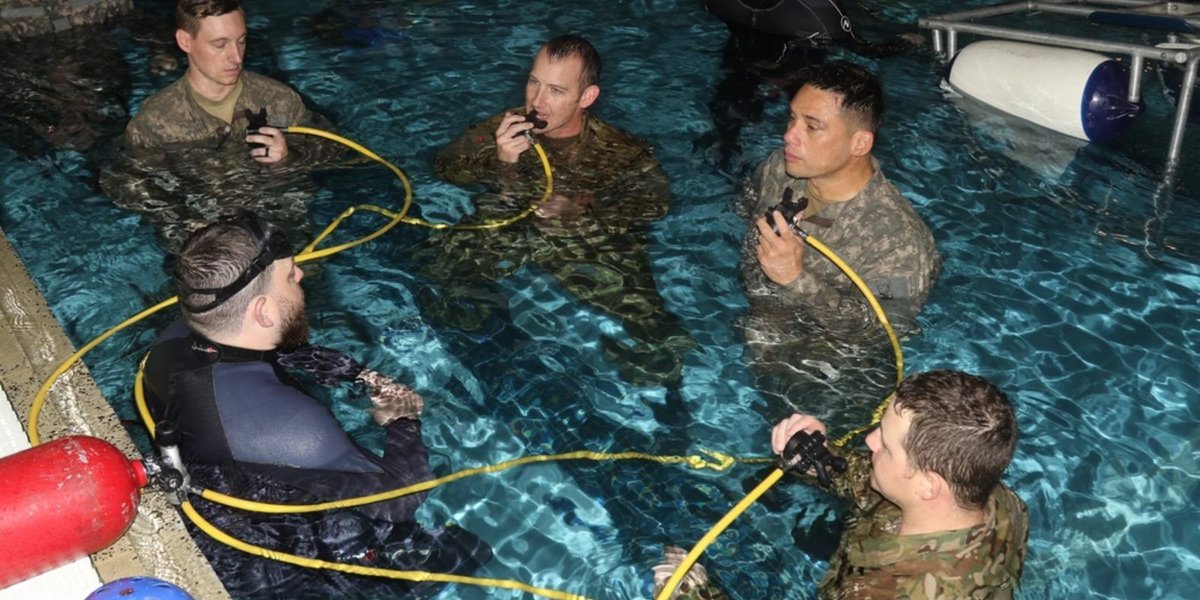A LOOK BENEATH THE SURFACE AT THE NAVY’S UNDERWATER TRAINING
By Michael Wang

Advertisement
Many people wonder what it’s like training for the U.S. Navy. Because the Navy’s in charge of protecting the United States on the water in sometimes hostile aquatic environments, most of their training consists of water in some way, shape, or form. It may not be common knowledge, but underwater training is a huge part of prepping to be a Sailor or special ops troop.
Recruits for the U.S. Navy must be trained to be skilled enough to successfully navigate high-pressure situations on and in the seas. Therefore, the U.S. Navy has its recruits train underwater to simulate situations that would require them to breathe underwater and get out of serious situations.
Read next: Take a Deep Dive Into the U.S. Navy’s Orca Submarine
What Is Underwater Training?
In the U.S. Navy, underwater training is crucial to the success of recruits both at the beginning and throughout their military careers. When it comes to underwater training, Sailors are taught to “hold their breath underwater for two to three minutes or more.” It’s imperative for incoming Sailors to be trained and prepared to hold their breath underwater in case of an emergency. Sailors also train underwater using a kettlebell to help increase their lung power and endurance. Through this type of underwater training, having the skill to hold your breath for a long period of time is to “condition a swimmer or diver to build confidence when going through high-surf conditions at night.” Additionally, recruits are trained using lots of important underwater gear. In Fleet Training, recruits who are assigned to one of the Navy Diving Units are “trained to perform underwater ship repair, salvage and construction, using either SCUBA equipment or a surface-supplied air diving system.” Another aspect of underwater training is “Combat Water Survival Exercises,” a series of intense scenarios meant to mimic the types of difficult at-sea conditions Sailors may face during their service. During this training, “candidates swim with their hands and feet bound [and] assemble machine guns underwater and on the seas in full combat gear.” Recruits train with their ankles and hands bound to each other during water training to test their ability to untie themselves to get themselves out of the water as soon as possible without drowning. The intensity of this combat water training is what makes Navy training one of the hardest regiments in the military. After finishing the training successfully, however, there’s no doubt that all Sailors are well-prepared to handle any and every situation that gets thrown at them – underwater or above it.What Is the Undersea Warfare Training Range?
New advancements are being created to provide an even more effective training style that will better prepare troops for any kind of underwater warfare they may face. To assist in this, a new facility called the Undersea Warfare Training Rage is being created. The Undersea Warfare Training Range, also known as USWTR, is “an expansive network of about 600 miles of undersea cables and acoustic sensors that provides a realistic training environment for tracking targets on the surface and subsurface.” In other words, the USWTR provides realistic training and enables ships, submarines, and aircraft to track their targets on the “surface and subsurface” for underwater warfare training. What are contained within the Undersea Warfare Training Range are “cables and highly sensitive sensors, and shore-based control, display and processing facilities, providing realistic training that increases capabilities.” The program also provides “shallow water and regional conflict operations training” to recruits. With this new addition to the Navy’s underwater training, recruits are equipped with the most advanced technology, which will help them protect themselves, the country, and our allies even more efficiently.Advertisement
What’s Currently Happening With Underwater Training in the U.S. Navy?
Recently, the U.S. Naval Air Systems Command announced the “full operational capability of the U.S. Navy’s Undersea Warfare Training Range Increment I (USWTR INC i) Program 13 months ahead of schedule.” Currently being managed by the Naval Aviation Training Systems and Ranges Program office, also known as the PMA 205, the Undersea Warfare Training Range will help shape the future of submarine warfare and naval capabilities. The significance of this announcement is that it allows recruits to start their training faster. With the program installing highly sensitive sensors, the new technology provides realistic training to the Navy that helps enable their ships and aircraft to detect targets that are rendered “hidden” in the depths of the ocean floor, thus increasing fleet capabilities and lethality. With the USWTR operating at full capacity, it has the potential to transform our Navy fleet, Sailors, and how we approach attack and defense tactics when the time comes for those measures. We’ll see how the Navy utilizes its new underwater training resource and enhances the future of the branch. Take a look at this: After All the Hell Week Deaths, How Are They Making Navy Training Safer?The appearance of U.S. Department of Defense (DoD) visual information does not imply or constitute DoD endorsement. Photo by Sgt. Daphney Black | 4th Combat Aviation Brigade, 4th Infantry Division Public Affairs
Written by
Michael Wang
Michael Wang is a Contributing Writer at VeteranLife.com.
Michael Wang is a Contributing Writer at VeteranLife.com.
Advertisement
SHARE:



